八年级英语上册Unit6教学设计
- 格式:doc
- 大小:32.00 KB
- 文档页数:4


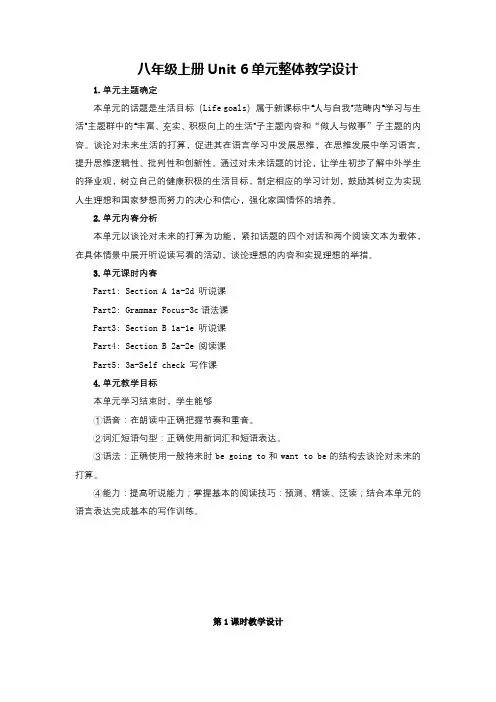
八年级上册Unit 6单元整体教学设计1.单元主题确定本单元的话题是生活目标(Life goals)属于新课标中“人与自我”范畴内“学习与生活”主题群中的“丰富、充实、积极向上的生活”子主题内容和“做人与做事”子主题的内容。
谈论对未来生活的打算,促进其在语言学习中发展思维,在思维发展中学习语言,提升思维逻辑性、批判性和创新性。
通过对未来话题的讨论,让学生初步了解中外学生的择业观,树立自己的健康积极的生活目标,制定相应的学习计划,鼓励其树立为实现人生理想和国家梦想而努力的决心和信心,强化家国情怀的培养。
2.单元内容分析本单元以谈论对未来的打算为功能,紧扣话题的四个对话和两个阅读文本为载体,在具体情景中展开听说读写看的活动,谈论理想的内容和实现理想的举措。
3.单元课时内容Part1: Section A 1a-2d 听说课Part2: Grammar Focus-3c语法课Part3: Section B 1a-1e 听说课Part4: Section B 2a-2e 阅读课Part5: 3a-Self check 写作课4.单元教学目标本单元学习结束时,学生能够①语音:在朗读中正确把握节奏和重音。
②词汇短语句型:正确使用新词汇和短语表达。
③语法:正确使用一般将来时be going to和want to be的结构去谈论对未来的打算。
④能力:提高听说能力;掌握基本的阅读技巧:预测、精读、泛读;结合本单元的语言表达完成基本的写作训练。
第1课时教学设计一、教学内容:Section A 1a-2d二、课型:听说课三、语篇研读What: 谈论未来的职业话题,1a罗列了本单元所学职业词汇,1a-1c按个人兴趣为职业排序、听力练习及对话训练,并引出本单元话题——生活目标,2a-2c的内容集中在打算如何实现理想。
2d是在原来话题基础上增加更为真实的情境——与他人交流未来的职业。
Why: 通过谈论未来的职业,运用一般将来时和相关职业类词汇,形成初步的语言结构认识并理解运用。
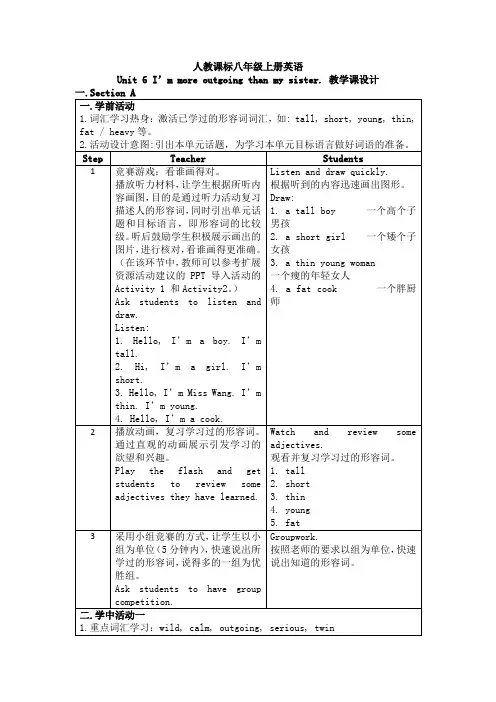
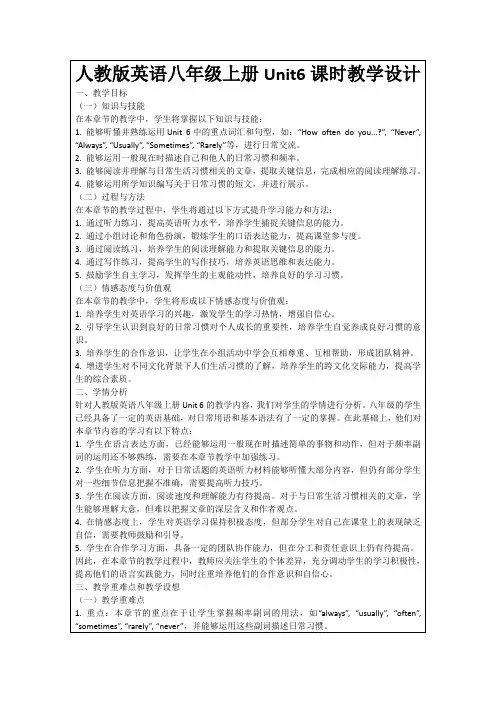

Unit 6 I'm going to study computer science.柴陇燕一、教学内容分析本节课的教学内容是人教版新目标八年级英语上unit6I'm going to study computer science的第一课时1a-1c。
本课位于人教版八年级上10 单元的第一部分,其主要内容就是学习关于职业的单词以及be going to的用法,用一般将来时谈论未来自己与他人理想的职业及原因,为实现理想所做出的打算和安排,以及制定未来一段时间内的学习计划。
目的是通过对人生理想的讨论使青少年在这个如花的季节不仅对未来有美好的憧憬,而且要从现在做起,为健康的理想而奋斗。
二、教学目标(1).知识目标: 要求学生掌握关于职业的名词computer programmer, computer science, engineer, pilot, professional ….本课主要句型:What are you going to be when you grow up? I’m going to be an engineer. How are you going to do that? I’m going to study math hard.语法:用be going to表示一般将来时。
(2).能力目标:能听懂有关人生理想的词汇及表达;能听懂有关未来计划的表达;能进行有关人生的谈话;能进行有关将来计划的讨论。
培养学生应用英语谈论将来计划,提高学生听、说、读、写等能力。
(3)情感目标:通过对人生理想的讨论,让学生从小就树立自己的人生理想,并且现在就下决心,为理想而努力奋斗。
使他们成为有理想,有抱负,有动力,健康成长的新一代青少年。
三、教学重点、难点。
(1)重点词汇:要求学生掌握关于职业的名词computer programmer, computer science, engineer, pilot, professional ….(2)重点句型:本节课要求学生掌握并能够正确运用:What are you going to be when you grow up? I’m going to be an engineer. How are you going to do that? I’m going to study math hard.(2)难点:一般将来时be going to 中be 的具体形式和后面接动词原形的用法学生容易混淆. 学生根据自己喜欢的职业,运用所学知识谈论自己打算怎样做来实现目标则既是难点,又是能力训练点。

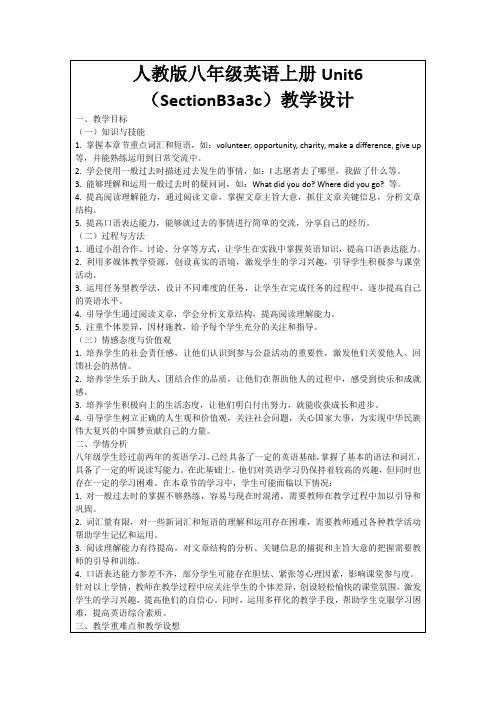

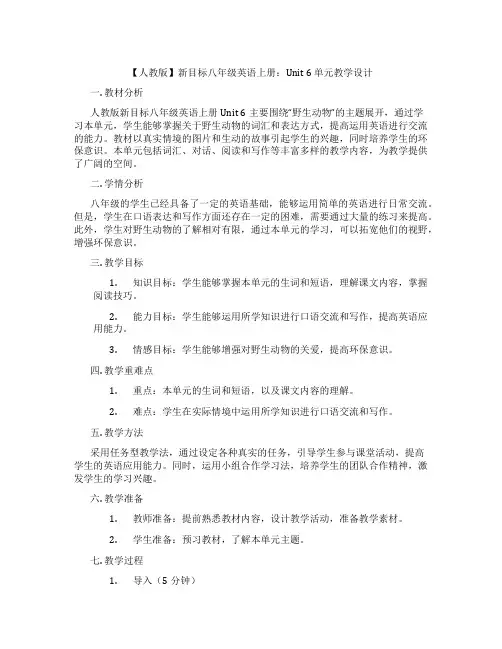
【人教版】新目标八年级英语上册:Unit 6 单元教学设计一. 教材分析人教版新目标八年级英语上册Unit 6主要围绕“野生动物”的主题展开,通过学习本单元,学生能够掌握关于野生动物的词汇和表达方式,提高运用英语进行交流的能力。
教材以真实情境的图片和生动的故事引起学生的兴趣,同时培养学生的环保意识。
本单元包括词汇、对话、阅读和写作等丰富多样的教学内容,为教学提供了广阔的空间。
二. 学情分析八年级的学生已经具备了一定的英语基础,能够运用简单的英语进行日常交流。
但是,学生在口语表达和写作方面还存在一定的困难,需要通过大量的练习来提高。
此外,学生对野生动物的了解相对有限,通过本单元的学习,可以拓宽他们的视野,增强环保意识。
三. 教学目标1.知识目标:学生能够掌握本单元的生词和短语,理解课文内容,掌握阅读技巧。
2.能力目标:学生能够运用所学知识进行口语交流和写作,提高英语应用能力。
3.情感目标:学生能够增强对野生动物的关爱,提高环保意识。
四. 教学重难点1.重点:本单元的生词和短语,以及课文内容的理解。
2.难点:学生在实际情境中运用所学知识进行口语交流和写作。
五. 教学方法采用任务型教学法,通过设定各种真实的任务,引导学生参与课堂活动,提高学生的英语应用能力。
同时,运用小组合作学习法,培养学生的团队合作精神,激发学生的学习兴趣。
六. 教学准备1.教师准备:提前熟悉教材内容,设计教学活动,准备教学素材。
2.学生准备:预习教材,了解本单元主题。
七. 教学过程1.导入(5分钟)利用图片或视频展示一些野生动物,引导学生谈论他们所知道的野生动物,激发学生的兴趣。
2.呈现(10分钟)教师通过PPT展示本单元的生词和短语,让学生朗读并理解其含义。
然后,教师呈现课文内容,引导学生跟读并理解课文大意。
3.操练(15分钟)教师设计各种情景,让学生运用所学知识进行口语交流。
如:模拟在动物园的对话、讨论保护野生动物的方法等。
4.巩固(10分钟)教师给出一些关于野生动物的图片,让学生用英语描述它们。
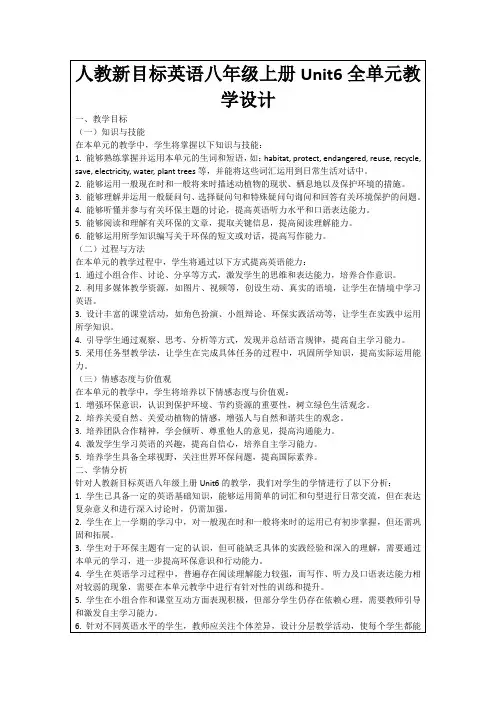
⼋年级英语上册Unit6教学设计⼋年级英语上册Unit6教学设计⼀、设计理念:《英语课程标准》指出:语⾔知识和语⾔技能是综合语⾔运⽤能⼒的基础。
⽽培养学⽣的综合语⾔运⽤能⼒是英语学习的总⽬标。
本节课以⼈物⽐较为载体,学习相同点与不同点的表达⽅法,丰富学⽣的语⾔知识,培养学⽣的语⾔技能,从⽽提⾼学⽣的综合语⾔运⽤能⼒。
⼆、教材分析1、教材的地位和作⽤:本课是《新⽬标英语》⼋年级上册“Unit 6I’m more outgoing than my sister. Section A”。
本课要分两课时完成。
内容是谈论两个⼈/物的相同点和不同点,重点学习形容词⽐较级的运⽤。
这是在对形容词进⾏了⼀年的学习之后,学⽣已经掌握形容词的使⽤之后进⾏的语⾔技能的提⾼。
也是学习本册书第⼗⼆单元最⾼级的基础。
2、教学⽬标的确⽴及依据:1)、语⾔知识与技能⽬标:能够⽤both正确表达⼈物或事物的相同点,能够系统总结并熟练掌握形容词⽐较级的运⽤,能够根据要求完成对于各种⽐较的表达。
2)、学习策略⽬标:引导学⽣积极思考,抓住要点,及时归纳总结,正确运⽤,培养学⽣良好的学习习惯,掌握有效的学习策略。
3)、情感态度⽬标:能体会学习英语的乐趣,增强学习英语的⾃信⼼。
4)、⽂化意识⽬标:引领学⽣融⼊到语境之中、进⼊到完全英语交际的氛围之中,培养学⽣的英语思维能⼒。
3、教学重点与难点:1)、重点及突破⽅法:⽤both表达相同点的⽤法及⽤形容词的⽐较级表达不同点的⽤法是本课的学习重点。
突破⽅法是分类练习、归纳总结,使学⽣在头脑中形成清晰的脉络。
2)、难点及攻克⽅法:难点是形容词的⽐较级的构成,攻克⽅法是按⽐较级的构成规律进⾏分类练习、归纳总结,采⽤情景教学的⽅式,把知识直观地展⽰给学⽣,并使学⽣得到充分的练习。
三、教学策略:1、学情分析:学⽣基础知识掌握较好,但不太喜欢⼝语表达,部分学⽣基础薄弱、归纳总结能⼒差。
所以需要努⼒营照宽松、民主、和谐的教学氛围,⿎励他们⼤胆尝试;并且,课堂节奏要适当,既要使学⽣们跟得上,⼜不能拖沓。
八年级英语上册-人教版-Unit 6 教学设计一. 教材分析人教版八年级英语上册Unit 6的主题是关于描述过去发生的事情。
通过本单元的学习,学生能够掌握一般过去时的用法,学会如何用英语描述过去发生的事情。
教材内容丰富,包括听、说、读、写等多个方面,旨在全面提高学生的英语能力。
二. 学情分析八年级的学生已经掌握了英语学习的基本语法和词汇,具备一定的听、说、读、写能力。
但部分学生对过去时的用法还不够熟练,需要通过本节课的教学来进一步巩固。
此外,学生在描述过去事件时,可能会存在表达不清、时态错误等问题,需要教师在教学中加以引导和纠正。
三. 教学目标1.知识目标:学生能够掌握一般过去时的构成和用法,学会如何用英语描述过去发生的事情。
2.能力目标:学生能够在实际情境中运用过去时进行交流,提高听、说、读、写的能力。
3.情感目标:培养学生对英语学习的兴趣,激发学生积极参与课堂活动的热情。
四. 教学重难点1.重点:一般过去时的构成和用法。
2.难点:如何正确运用过去时描述过去发生的事情,并在实际情境中进行交流。
五. 教学方法1.情境教学法:通过设置各种真实的场景,让学生在实际语境中学习并运用过去时。
2.任务型教学法:通过完成各种任务,激发学生的学习兴趣,提高学生的参与度。
3.交际式教学法:鼓励学生积极参与课堂交流,提高学生的听说能力。
六. 教学准备1.教师准备:准备好相关的教学材料,如PPT、图片、视频等。
2.学生准备:预习本节课的内容,了解一般过去时的基本用法。
七. 教学过程1.导入(5分钟)教师通过提问引导学生回顾过去时的一般疑问句和回答方式,激发学生的学习兴趣。
2.呈现(10分钟)教师展示PPT,呈现本节课的主要内容,包括一般过去时的构成、用法以及相关词汇。
同时,教师可以通过图片、视频等材料,为学生提供直观的感官体验,帮助学生更好地理解和记忆。
3.操练(10分钟)教师学生进行小组活动,让学生用过去时描述发生在小组成员之间的故事。
八年级英语上册Unit6教学设计
一、设计理念:
《英语课程标准》指出:语言知识和语言技能是综合语言运用能力的基础。
而培养学生的综合语言运用能力是英语学习的总目标。
本节课以
人物比较为载体,学习相同点与不同点的表达方法,丰富学生的语言知识,培养学生的语言技能,从而提高学生的综合语言运用能力。
二、教材分析
1、教材的地位和作用:
本课是《新目标英语》八年级上册“Unit 6I’m more outgoing than my sister. Section A”。
本课要分两课时完成。
内容是谈论两
个人/物的相同点和不同点,重点学习形容词比较级的运用。
这是在对形容词进行了一年的学习之后,学生已经掌握形容词的使用之后进行
的语言技能的提高。
也是学习本册书第十二单元最高级的基础。
2、教学目标的确立及依据:
1)、语言知识与技能目标:
能够用both正确表达人物或事物的相同点,能够系统总结并熟练掌握形容词比较级的运用,能够根据要求完成对于各种比较的表达。
2)、学习策略目标:
引导学生积极思考,抓住要点,及时归纳总结,正确运用,培养学生良好的学习习惯,掌握有效的学习策略。
3)、情感态度目标:
能体会学习英语的乐趣,增强学习英语的自信心。
4)、文化意识目标:
引领学生融入到语境之中、进入到完全英语交际的氛围之中,培养学生的英语思维能力。
3、教学重点与难点:
1)、重点及突破方法:
用both表达相同点的用法及用形容词的比较级表达不同点的用法是本课的学习重点。
突破方法是分类练习、归纳总结,使学生在头脑中形成
清晰的脉络。
2)、难点及攻克方法:
难点是形容词的比较级的构成,攻克方法是按比较级的构成规律进行分类练习、归纳总结,采用情景教学的方式,把知识直观地展示给学生
,并使学生得到充分的练习。
三、教学策略:
1、学情分析:
学生基础知识掌握较好,但不太喜欢口语表达,部分学生基础薄弱、归纳总结能力差。
所以需要努力营照宽松、民主、和谐的教学氛围,鼓
励他们大胆尝试;并且,课堂节奏要适当,既要使学生们跟得上,又不能拖沓。
2、教学方法及手段:
利用多媒体教学手段,采用情景交际教学法及运用看录像的方式,有针对性地对both的运用和形容词比较级的各种书写方式进行训练,继而
指导学生利用比较归纳法和分类记忆法进行总结。
之后,呈现习题进行训练,培养并强化学生的语言实践能力和自主学习能力。
四、教学程序设计:
1、新课导入:
本课重点是学会表达人物外貌和性格的相同点和不同点,因此,事先总结有关人物外貌和性格的形容词是很必要的。
所以,我以What does
he / she look like? What is he / she like? 展开词汇归类的角逐,继而导入新课。
2、探索新知:
1)、相同点的学习:即both的使用
①、借助多媒体呈现成对人物,并出现We both,引导学生自主发挥,用“both +动词”表述共有的外貌特征。
之后,拓展提高,要求学生
介绍两位较相似的人,巩固提高以上所学。
②、借助多媒体呈现成对人物,并出现They are both,引导学生自主发挥,用“系动词+both”表述共有的外貌特征和性格特点,之后,拓
展提高,要求学生介绍两个人物的相同点,巩固提高以上所学。
2)、不同点的学习:
①、比较级是本课教学的难点。
为了攻克这一难点,我采用分类呈现的方法,把比较级的书写规律直观地展示给学生。
②、趁热打铁,总结比较级的构成规律。
③、实践应用:播放视频,引导学生感知比较级的运用。
之后,比较特异双胞胎,比较秀兰·邓波的儿童照和成年照(这一步的设计也是为
第九单元的学习打下基础)。
④、拓展与提高比较班内的两个同学,找出两者外貌和性格的不同点。
由于初中阶段英语的书面表达是以仿写为主,所以我呈现了表达的
套用形式供学生参考。
3、能力提升:
运用猜谜的方式:先把全班学生的人名分别写在条上,让参加的学生抽条,之后说出条上学生与自己的相同点与不同点,其他人在他说的过
程中进行猜测,直至猜中为止。
4、评价:
用大屏幕呈现习题,巩固所学。
5、作业:
从相同点和不同点两个方面完成书面表达: “My Best Friend and I”。
词数:60~80词。
6、小结:
学生总结本课内容。
五、反思:
首先,通过学习,学生对表述人物外貌和性格的形容词进行了较为全面的总结。
其次,由于引入时是分类引入的,学生对知识点的掌握也就在一开始就进入了分类状态,所以在之后的综合表达环节出现的混淆现象比预计
的要少。
最后,语言学习是一个循序渐进熟练的过程。
因此,还应在以后的教学之中反复出现、反复练习,最后达到完全掌握,从而真正提高学生综
合语言运用的能力。